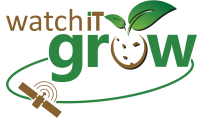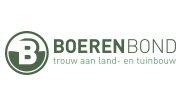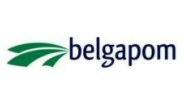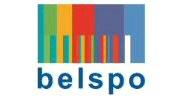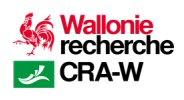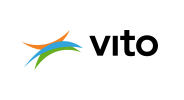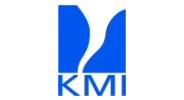General info on WatchITgrow
What is WatchITgrow?
WatchITgrow is an online platform to support farmers to monitor arable crops and vegetables more efficiently in view of increasing yields, both qualitatively and quantitatively. WatchITgrow uses various types of data starting with satellite data combined with e.g. weather data, soil data, IoT data and field data provided by the farmer. These data will be combined using new technologies such as big data analytics and machine learning to provide farmers with more timely and personalized advice.
Why should I use WatchITgrow?
WatchITgrow provides information on crop growth and development as observed from satellite images. From the greenness maps you can easily detect variability within your field and compare crops growing on different fields. By monitoring the weather data (temperature and rainfall) you can better assess the risk for production or quality losses at your fields. Further you can create application maps for variable rate planting, by accounting for the shadow zones within your field, and for variable rate fertilization. Later in 2019 it will also be possible to make application maps for variable rate irrigation and haulm killing. Finally WatchITgrow also provides yield forecasts for 2 potato varieties, Bintje and Fontane. These forecasts are generated at field level and are only available for the individual farmer.
You can also use WatchITgrow to store your field data: general information such as the variety, planting date, harvest date or more specific information on application of fertilizers, pesticides, irrigation,… As a farmer you decide whether or not you share these data with your advisor, contractor, buyer,…
Who are the intended users of WatchITgrow?
WatchITgrow is a collaboration platform for everyone in the agricultural sector, from farmers, contractors and advisors to buyers. The platform offers numerous functionalities and benefits to monitor your crops more smoothly, but it also offers the possibility to set up a closer cooperation between individual farmers and buyers.
Which crops can I monitor with WatchITgrow?
The most common arable crops and vegetables can be monitored with WatchITgrow. Yield forecasts, however, are only available for potatoes.
Data privacy
Who is owner of the data?
The data of the user remain property of the user at all times. VITO, as an independent party, guarantees full data privacy, data security and data access. Main principle in this setup is that the user can indicate whether or not he wishes to share his data, which data he wants to share and with whom he wishes to share these data. The user can revoke or change any of the decisions at any time.
Who can see the data I entered for my field?
When you are entering data as a farmer (and owner of the data) you are the only one who can see the data. If you want to share data for a certain field, for instance with an advisor or contractor, you can do this via the “Data sharing” button. In that case, the person to whom you give permission can see and edit all the information that is available for this field, except information on the actual yield of the field, the buyers, contracted volumes and bonus payments. As a farmer you can withdraw this permission at any time.
Can I also see data from other fields?
You cannot see specific field data that have been entered by a farmer for a field unless the farmer gives you permission to view the data. Information on the actual yield of the field, the buyers, contracted volumes and bonus payments is never shared with other users.
From the satellite based greenness maps you can see other fields as the satellite images (which are publicly available data) are covering the whole country and provide a picture of all fields.
What happens when I share data?
The person to whom you give permission can see and edit all the information that is available for the field you share. Information on the actual yield of the field, the buyers, contracted volumes and bonus payments is never shared with other users. As a farmer you can withdraw this permission at any time.
Wat happens with the data I submit?
Upon registration you are asked to give permission to use your data for scientific research in order to develop new features which will be made available to the users again via the WatchITgrow platform.
New technologies allow us to combine data from different sources: satellite images, weather and soil data but also your field data, and to convert them into practically useful information, aiming to offer automated advice to individual farmers.
WatchITgrow uses big data analytics and machine learning algorithms. These techniques are very suitable for analyzing a large amount and diversity of data and recognizing patterns in it. From this knowledge we can provide farmers with more timely and personalized advice to increase their yields.
How to use WatchITgrow as a farmer?
Adding fields for monitoring
How can I start to monitor my fields?
Under “My Fields” you can add your fields by clicking on the “+Add Field” button. There are three ways to add fields:
- - by selecting fields from an existing field layer (click on “Select”)
- - by drawing fields (click on “Draw”)
- - by importing field boundaries e.g. after planting with GPS (click on “Import”)
How to select fields for monitoring?
Under “My Fields” you can add your fields by clicking on the “+Add Field” button. The “Select” button is activated by default. First you need to select the (harvest) year and crop. The fields from which you can select in that year are highlighted in blue. You can select one or more fields by clicking on the field(s), adding the field name, harvest year, crop type and variety. When you are ready you click on “Submit”.
Where do the field boundaries for selection come from?
Flanders:
The field boundaries that you see are the boundaries of the potato fields that were declared as such to the Flemish government (these are publicly available data). When changing the year and crop type you will see that different fields will become available for selection. For the ongoing year it may happen that (early in the season) the declared info is not available yet. In that case, you will see the boundaries of all agricultural fields that were declared as such the previous year and you can start selecting your fields from this layer.
Wallonia:
The field boundaries that you see are the boundaries of all agricultural fields that were declared as such to the Walloon government in 2017 (these are publicly available data).
How to draw fields?
Under “My Fields” you can add your fields by clicking on the “+Add Field” button. When you click on the “Draw” button you can draw your field by clicking at the corner points of your field. When you are ready you click on “Save”. Then you will be asked to provide for each field that you have drawn the field name, harvest year, crop type and variety. When you are ready you click on “Submit”.
How to import fields?
Under “My Fields” you can add your fields by clicking on the “+Add Field” button. When you click on the “Import” button you can drag and drop a .kml or a .zip file containing .shp+.shx+.dbf+.prj files with your field boundaries or browse to such files. When you are ready you click on “Save”. Then you will be asked to provide for each field in the shapefile the field name, harvest year, crop type and variety. You can enter these data separately for each field by selecting “Manual” for field name, harvest year, crop type and variety or you can copy the data from the shp file by selecting the corresponding name from the attributes list. This way you can e.g. indicate that the “field name” that you have to enter corresponds with the “name” attribute from the .shp file. To enter the harvest year you will most likely select “fixed year” for all fields. When the same crop is grown on all the fields you want to enter you can select that crop from the “crop type” list. When you want to enter fields with different crops you can choose “Manual” for crop type.
Import fields: which formats are supported?
Currently only .kml and .shp files are supported with coordinates in lon/lat (EPSG:4326 / WGS 84). The .shp files together with the .shx, .dbf and .prj files have to be zipped prior to upload.
I see differences between the field boundaries I have drawn and the field boundaries on recent greenness maps, why?
The field layer that is used for selecting your fields for monitoring is updated once a year at the end of May. Before that time the field layer of last year is shown. Also, the satellite images that are used as background for drawing your fields are satellite images from previous years.
For these reasons it may happen that the selected or drawn field boundaries deviate from the actual field boundaries as visible on the satellite images. In such cases we suggest to edit the field borders. Otherwise the greenness graph will not only represent the result of your field but also a part of the neighboring field(s).
How to change the field boundaries?
You can change the field boundaries by clicking on the pencil icon on the greenness map in the Field dashboard. Then you click on that part of the boundary where you want to make changes. A point will appear. You can now drag this point to the right location. When you are ready you can save the edits by clicking on Save. You are then redirected towards the Field dashboard.
How to delete a field?
You can delete a field by clicking in the Field dashboard on the red “Delete” button.
Crop monitoring: accessing available data and adding new data
How can I find the fields I entered?
If you click on the “My fields” button in the main menu you will see a list with the fields you have entered so far.
I see my field in the list, how can I get more info for my field?
When you click on a field in the list you will be directed towards the Field dashboard. There you can access information (satellite images, weather data), create application maps or add your own field data (field actions, observations).
How can I add my field data?
When you click on a field in the list of fields you are directed towards the Field dashboard. Here you will find general information on your field and crop which you can edit or complete if needed. Via the “+Field actions” button you add data on planting, fertilization, crop protection, irrigation or harvest activities. Via the “Observations” button you can provide information on the crop’s development stage or report damages observed at the field.
Can I add field data for more than one field at the same time?
Yes, you can. In the List of fields you can select multiple fields via the check boxes and add data for all selected fields by clicking on the “+Actions” button on top. This way you can for instance add the planting date, variety,… for several fields in one action.
Where can I enter or update my company details?
Company info can be added or updated in your Profile. You can go there by clicking in the main menu on top on your user name and then selecting the Company tab.
Where do I find meteo data?
You can see temperature and rainfall maps by clicking on “Global maps” in the main menu on top and then selecting “Temperature” or “Rainfall”.
Graphs showing the actual temperature, rainfall and rainfall sum compared to average can be found in the Field dashboard by clicking on the “Statistics” button or by navigating to “Statistics” in the menu on the left.
Where do I find satellite images?
You can see satellite images by clicking on ”Global maps” in the main menu on top and then selecting “Satellite” (natural color images) or “Greenness” (index derived from these satellite images).
You can also directly access the greenness map of your field via the Field dashboard. By clicking on the “enlarge” icon you will get a larger overview of the field and its surroundings and you will be able to view images of previous periods.
Graphs showing the greenness compared to the regional and reference greenness can be found in the Field dashboard by clicking on the “Statistics” button or by navigating to “Statistics” in the menu on the left.
Can I also see satellite images of previous periods?
Yes, you can see satellite images of previous periods or years by navigating through the greenness thumbnails below or you can change the year to view satellite images of a particular year.
How often do you get new satellite images?
The Sentinel-2 satellites pass every 5 days and in parts of Belgium even more frequently.
Where can I find the field history?
The main crop of last season is shown in the Field dashboard in the Field data box. By clicking on “more info” or by navigating in the menu left via Field data to Field history you get an overview of all main crops that have been grown on the field since 2013. Here you can also add the pre-crop or winter cover crop.
Where can I find the soil map?
You can access the soil map of Belgium by clicking on “Global maps” in the main menu and then selecting “Soil”.
How can I find the elevation map?
You can access the elevation map of Belgium by clicking on “Global maps” in the main menu and then selecting “Elevation”.
Creating application maps
Where can I create application maps?
You can create application maps by clicking in the Field dashboard on “+Application map” or by navigating to “Application maps” in the menu on the left.
Where do I find application maps that I have previously created?
Previously created application maps can be found by clicking on the “+Application map” button in the Field dashboard or by navigating to “Application maps” in the menu on the left. There you will find an overview of your application maps.
Which types of application maps can I create?
Currently you can create application maps for variable rate planting (based on shadow zones) and fertilizing. Later in 2019 it will be possible to create application maps for variable rate irrigation and haulm killing (for potatoes).
How do I create a shadow map (an application map for variable rate planting?)
You can create a shadow map for your field from the Field dashboard by clicking on “+Application map” or by navigating to “Application maps” in the menu left. There you select “Create application map” and follow the different steps. In step 1 you choose “planting” and you go to the next step. There you can enter the normal planting distance for this field. By clicking on “calculate planting distances” the planting distances for the sunny, half shadow and shadow zones will be calculated automatically. If needed you can still change these distances. In addition to the solar radiation map you can also load the soil map, elevation map and recent satellite images via the check boxes. In the last step you can enter the name of the shadow map and, optionally, an advice date for planting. You can download the shadow polygons and the respective planting distances as a shapefile by clicking on the download button below or you can just save the map you created.
How can I use the shadow map?
The shadow map shows you the sunny vs. shadowed parts of your field. You can use this map as input for variable rate planting. By planting less in the shadowed parts the plants get more sunlight, water and nutrients compared to when you apply a normal planting density and this will result in higher yields. The map is also a handy tool for creating green zones in the shaded field borders in the frame of the greening obligations.
Why don’t I get shadow maps for my field?
Currently shadow maps are only available for Flanders. In the near feature these shadow maps will also be produced for fields in Wallonia.
How do I create an application map for variable rate fertilization?
You can create a fertilizer map for your field from the Field dashboard by clicking on “+Application map” or by navigating to “Application maps” in the menu left. There you select “Create application map” and follow the different steps. In step 1 you choose “fertilizing” and you go to the next step. In step 2 you select the machine that will be used for fertilizing, the type of fertilizer (mineral, organic, compost) and the product(s) you will apply. You can select one or more products from the list of existing (mineral) fertilizers or you can create your own product. If you choose the latter option you can add minerals one by one. When adding the product you are also asked to add the normal dose you would apply for the field, in kg/ha or l/ha. In step 3, by clicking on “Auto dosage”, the normal product dose is distributed over the different zones within the field according to the selected strategy. “Make bad areas better” applies a higher dose of fertilizer to zones with a low greenness index. When you select “Make good areas better” a higher dose will be applied to zones with a high greenness index. If needed you can still change the dose. You can create application maps for different dates, using different satellite images as input, by changing the “Application map date”. You can also load the soil map, elevation map and recent satellite images via the check boxes. In the last step you can enter the name of the application map and, optionally, an advice date for fertilizing. You can download the polygons and the respective fertilizer dose to be applied as a shapefile by clicking on the download button below or you can just save the map you created.
How are the zones for variable rate fertilization calculated?
To define the zones we use greenness (fAPAR) images derived from Sentinel-2 satellite images. The greenness of each pixel in the field is compared with the median greenness of the field and attributed to one of the following 5 classes: <85%, 85-95%, 95-105%, 105-115%, >115% of the median value.
How is the fertilizer dose distributed over the different zones?
For calculating the fertilizer dose for the different zones, we look at the difference between the actual greenness in the zone and the median greenness of the field. This ratio (zone / median greenness) is then applied to the normal fertilizer dose according to the chosen strategy ("make bad areas better" or "make good areas better"). An example: in the zone where the greenness is situated between 85 and 95% of the median value, the fertilizer dose will be 10% higher or 10% lower than the normal dose, depending on the strategy that was chosen.
Yield forecasts for potatoes
Where can I find yield forecasts?
Yield forecasts for your potato fields can be found in the Field list under “My Fields” and in the Field dashboard.
Who can see the yield forecasts for my field?
The yield forecasts are only visible for the owner of the field. These data are not shared. From 2019, average yields per municipality, province or agricultural region are no longer published.
How are yields forecasted?
Yield forecasts are based on crop growth models. These models use meteo and satellite data as input and require soil and crop/variety specific parameters
I don’t find yield estimates for the current year, why not?
Accurate yield forecasts can only be provided from the end of July onwards.
I can only get yield estimates for 2 varieties, why?
For setting up accurate yield forecasting models lots of data are required (among other from yield samplings). This process can several seasons. Forecasting models for Bintje and Fontane were derived in the frame of the iPot research project. That is why we currently only provide yield forecasts for these 2 varieties.
How accurate is the yield forecast?
Every year the yield forecasting model is fed with more data and will become more and more accurate.
How do you take yield samples?
For yield sampling we ask you to harvest from the end of July until harvest with 2-weekly intervals in each field 4 times 3 meters of plants.
Tips and tricks for sampling:
-
- Sampling starts between 2 plants and covers exactly 3 meters
- If after 3 meters you end in the middle of a plant, only take half of the plant
- When you have harvested the first 3 meters you can skip a few plants and then start to harvest the next 3 meters
- For fields of more than 5 ha you should repeat the procedure for each 5 ha zone
On the field you can already do a first set of measurements:
-
- Number of plants per sample
- Number of tubers per plant (all tubers with a diameter of more than 1cm should be counted)
- Number of stems per plant
- After sorting all tubers: % 35-50mm and % larger than 50mm
Then you collect the tubers of each sample in a plastic bag and you label the bag with the field ID, date of sampling and number of the sample (1 to 4). Avoid to leave the samples in the sun. If needed, you can keep the bags in cold storage (6°C) for 48 hours max. before doing additional analyses in the lab.
Once in the lab you do the following measurements:
-
- Weight of the individual samples. Therefore you use a balance which measures from 0 to 30kg with a precision of 5g.
- Under water weight. Therefore you need 3 to 5kg of tubers, from each individual sample.
Tips and tricks for lab measurements:
-
- The tubers need to be washed before weighing them.
During the first sampling rounds in July it may happen that you don’t have the minimum amount of 3 kg of tubers that is needed to determine the under water weight. In that case you can use the tubers of more than one sample.
Source and meaning of the available data
Where do the meteo data come from?
Temperature and rainfall data are collected at weather stations and further processed and distributed by the Belgian Royal Meteorological Institute.
How frequently are the meteo data updated?
The meteo data are updated every day. Meteo warnings (if any) are issued on a daily basis. Temperature and rainfall maps and graphs are updated once a week, on Monday, for the past week.
Where do the blocks in the meteo data come from?
Temperature and rainfall data are collected from more than 200 weather stations all over the country. The weather station data are interpolated to a “grid” of 5x5km in size. For temperature a simple average is calculated from the surrounding weather station measurements, with a correction for the altitude difference between the station and grid cell centre. Rainfall data are taken directly from the closest station.
What do the meteo maps represent?
The temperature and rainfall maps show the deviation of the actual temperature / rainfall with the average or normal temperature / rainfall on a weekly basis. The 5 classes in the legend are defined by analyzing the historical meteo archive. If a grid cell is classified as “much warmer / colder than usual” or “much wetter / drier than usual” it means that the temperature or rainfall in that grid cell belongs to the 20% warmest / coldest or wettest / driest observations in the history of that grid cell. For the other classes the deviations are smaller.
What is the meaning of the temperature and rainfall graphs?
The graphs show you on a weekly basis for your field
- the temperature (red line) compared to the long term average temperature (dark grey line)
- the rainfall (blue bars) compared to the long term average rainfall (light grey bars)
- the rainfall sum (blue line) compared to the long term average rainfall sum (light grey line)
The rainfall sum can be calculated starting from any date by moving the slider below.
Where do the satellite images come from?
For deriving the greenness maps we use images from the Sentinel-2A and 2B satellites. The greenness graph is based on a combination of Sentinel-2 (optical) and Sentinel-1 (radar) images. Sentinel-1 satellite images are not affected by clouds.
What is the spatial detail of the satellite images?
Sentinel-1 and 2 images have a pixel size of 10x10m.
The greenness map is loading but I cannot see satellite observations for my field, why not?
When the Sentinel-2 satellite passes and the sky above your field is cloudy you won’t get a usable satellite observation.
What is the meaning of the greenness map?
The underlying indicator is fAPAR. It represents the fraction of the sunlight that is used for photosynthesis. fAPAR is a measure of the crop’s primary productivity and is often used as an indicator of the state and evolution of crop cover. Low greenness index values (brown colour) mean that there is no crop growing on the field yet (bare soil). When the crop is growing the greenness index will increase (green colour) until the crop has reached maturity. Then the index will decrease again until harvest.
Why do I see different colors in the greenness map of my field?
Differences in greenness within a field indicate that crop growth may be variable within the field. Underlying causes may be diverse and can range from (natural) soil heterogeneity to climate induced problems such as drought or water logging, or local damages due to pests or diseases, emergence problems of seed potatoes, etc.
What is the meaning of the greenness graph?
The greenness graph allows you to monitor crop growth during the season and provides an indication on the development stage of the crop. The green curve in the graph below represents the greenness index. It shows you what the satellite measures. The pictures below show you what is happening on the field at the same time.
What is the meaning of the regional greenness?
The regional greenness shows the greenness of the fields, in a radius of 10km around the field, where the same crop is grown. This allows you to benchmark your field with comparable fields in your surroundings.
What is the meaning of the reference greenness?
The reference greenness shows the greenness that is expected under ideal growing conditions. The reference greenness is based on the greenness observed on a number of reference fields during the seasons 2015-2018. This information is currently only available for potatoes, for the varieties Bintje and Fontane.
Because the start of the growing season is weather and region dependent, the actual and reference greenness curves are synchronized every year based on the estimated emergence date.
I don’t see the reference greenness for my field, why not?
The reference greenness is only available for potatoes, for the varieties Bintje and Fontane.
What is the meaning of the greenness deviation in the Field list?
The greenness deviation refers to the difference between the actual and reference greenness. Based on this deviation you can rank your potato fields from well performing fields (positive greenness deviation: actual > reference) to badly performing fields (negative greenness deviation: actual < reference) and vice versa. Greenness deviations can also indicate that your crop is growing faster or slower than normal. In such cases the greenness curve will be resp. narrower or larger than normal and the slopes of the curve will deviate.
I don’t see the greenness deviation for my field, why not?
The reference greenness and hence also the deviation between the actual and reference greenness is only calculated for potatoes, for the varieties Bintje and Fontane.
Where does the soil map come from?
The soil map of Flanders is made available by the Flemish Government via Geopunt Vlaanderen. The soil map of Wallonia is made available by the Walloon Government via Géoportail de la Wallonie (WalOnMap).
Where does the elevation map come from?
The elevation map of Flanders is made available by the Flemish Government via Geopunt Vlaanderen. The elevation map of Wallonia is made available by the Walloon Government via Géoportail de la Wallonie (WalOnMap).
Where does the field history come from?
The field history (main crops since 2010) is made available by the Department of Agriculture and Fisheries of the Flemish Government.
Why is the field history not available for my field?
The field history is only available for fields located in Flanders.
What is the meaning of the warnings in the field list?
Under Warnings we indicate with an icon if the crop suffers from drought, excessive rainfall or heat or if the variability within the field is large.
Exporting field data
Can I export field data from WatchITgrow?
Yes, you can export your field data to a PDF report. The meteo and greenness graphs can be exported to CSV files. Therefore you go to the Field dashboard, you click on the Export button and select PDF or CSV. The result can be found in your Downloads folder.
Can I export field data for more than one field at the same time?
Yes, you can. In the field list under “My Fields” you can select multiple fields via the check boxes and export the data from all the fields you selected to separate PDF or CSV files by clicking on the “Export” button on top.
Sharing field data with other users
How can I share my field data?
If you want to share your field data you need to do this for each field separately. Therefore you go via My Fields to the Field dashboard of the field you want to share. In the Field dashboard you click on the “Data sharing” button or you navigate via the menu on the left to Field data and then to “Data sharing”. There you can add the user with whom you wish to share your data by entering his/her e-mail address if it is a new user, or by selecting the user from the list of existing users. The user with whom you wish to share your data must of course have a WatchITgrow account.
Where can I see with whom I have shared my field data?
In the Field dashboard you see the name of the user(s) with whom you have shared your field data. You can also find this information by clicking on the “Data sharing” button or by navigating via the menu on the left to Field data and then to “Data sharing”.
If I share my field data with another user, what can this user then do with my data?
The user with whom you have shared your field can add and edit data for this field. You will automatically see the changes via your personal account.
Users with whom you share your data cannot share them with other users.
Which data are shared?
If you share a field all the data you have added for this field will be visible for the person with whom you shared your field, except information on the actual yield of the field, the buyers, contracted volumes and bonus payments. This information is not shared with other users.
How can I withdraw the permission for data sharing?
To withdraw the permission of a user with whom you are sharing your data you go via My Fields to the Field dashboard. There you click on the “Data sharing” button or you navigate via the menu on the left to Field data and then to “Data sharing”. You can remove the user with whom you no longer wish to share your data from the list by clicking on the recycle bin next to the user’s name.
Exchange of information with advisors or contractors
How can I use WatchITgrow for exchanging information with my advisor or contractor?
You can exchange information with your advisor or contractor provided that you share your field with this person. Your advisor or contractor can then monitor your field and add or edit data for your field.
Where do I find the information added by my advisor?
The information that your advisor provides via WatchITgrow, i.e. a task or field action (fertilization, irrigation, crop protection or harvest) that needs to be performed on a specific date for a specific field can be found in the main menu under “My Tasks”. By clicking on the task you are directed towards the Field dashboard where you can find more information on the task.
How can I give instructions to my contractor via WatchITgrow?
As a farmer you can add an advice date and (if applicable) an advice dosis for “field actions” (planting, fertilization, crop protection, irrigation, harvest) via the Field dashboard. The contractor with whom you have shared your field will find these tasks in the Task list under “My Tasks”. The contractor can provide feedback to you on the execution of the task by adding information to your field via “Field actions”.
How to use WatchITgrow as an advisor?
Where can I find the fields of my farmers?
You can find the fields that farmers have shared with you in your the list under “My Fields” (in the desktop, tablet and smartphone version). For each field you can see the name of the owner / manager of the field. As an advisor you have access to all field data, except the actual yield of the field, the buyers, contracted volumes and bonus payments, you can edit these data or add new data.
How can I use WatchITgrow to exchange information with my farmers?
You can provide advice for the fields that farmers have shared with you via the Field dashboard. By clicking on “+Field actions” or by navigating to “Field actions” on the menu on the left, you can add the advice date and (if applicable) dosis for the concerned field action (planting, fertilization, crop protection, irrigation, harvest). The farmer will find this information in his task list under “My Tasks”.
How can I see if the farmer followed my advice?
If the farmer, after executing the task, has added the execution date or other info related to the execution of the field actions, you will find this information in the Field dashboard.
How to use WatchITgrow as a contractor?
Where can I find the fields of my farmers?
You can find the fields that farmers have shared with you in the list under “My Fields” (in the desktop, tablet and smartphone version). There you can also see the name of the owner / manager of the field. As a contractor you have access to all field data, except the actual yield of the field, the buyers, contracted volumes and bonus payments, you can edit these data or add new data.
How can I see which farmers have given me tasks?
In the desktop and the tablet version you will find the tasks that farmers have given to you in your Task list under “My Tasks”. In the list you see the name of the field and the field owner / manager, the task and the requested execution date.
In the smartphone version you will see the Task list when you click on the field.
How can I indicate in WatchITgrow that I have executed the task?
In the Field dashboard you can add info on the task(s) you have executed (planting, fertilization, crop protection, irrigation, harvest) by clicking on “+Field actions” or by navigating to “Field actions” via the menu on the left and adding the execution date or more specific info on the executed task.
WatchITgrow for smartphones
Which information is available via smartphone?
The smartphone version of WatchITgrow is meant to facilitate data input from the field. Via “My Fields” you get an overview of your (own and shared) fields whereby for each field the distance to your current location is shown. When clicking on a field you are directed towards the Field dashboard. Next to the main field data and warnings you will also find here the task list for this field. Via the “+Field actions” button you can enter data related to planting, fertilization, crop protection and harvest. Via the “+Observations” button you can add info on the development stage or report any damages.
Which info is not available via smartphone?
Maps and graphs cannot be accessed via the smartphone version.
How can I easily search for fields?
The fields close to your current location are shown on top of the field list, the more distant fields can be found further down the list. By clicking on “Filter” you can decide to sort your fields on crop type, distance or field name. You can also indicate that you only want to see fields where a certain crop is grown, fields in a certain region or from a certain harvest year by selecting a crop type, region and harvest year and clicking on Save.
Bonus system for potatoes
What is the bonus system for potatoes?
Belgian potato farmers can receive a financial bonus from their buyers (companies associated with Belgapom) when they actively use the WatchITgrow platform to submit field data (digital “field sheet”) and info on irrigation and actual yields.
What are the conditions for obtaining the bonus?
As potato farmer you can receive a financial bonus from your buyer as a compensation for the effort you have to make to collect and submit your field data through WatchITgrow.
Precondition for bonus payments is that you have a bonus agreement with your buyer.
As a farmer, you then need to register your contracts with (potentially: various) buyers in WatchITgrow:
- Name of the buyer
- Contracted variety
- Contracted volume (in metric tons) per buyer
To be eligible for the bonus, the contracted volume must be at least 100 tons across all buyers.
The fields from which you can potentially deliver the contracted potatoes also need to be registered in WatchITgrow (by selecting or drawing the fields).
Finally, for these fields, you:
- Enter all field data in WatchITgrow (digital “field sheet”)
- Deliver the additional data elements (actual yield per field at the end of the season and irrigation data)
The bonus will be limited in time (season 2019 and 2020) and is to be negotiated on a yearly basis.
Which bonus amount will I receive?
As an active user of WatchITgrow you will receive from your buyer a financial bonus of 0,35 euro per ton of contracted potatoes with a minimum of 250 euro and a maximum 750 euro per buyer, if you meet the above conditions.
Where can I find information on the bonus?
Information on the bonus can be found by clicking on “Bonus” in the main menu. Here you can register your contracts and you can see the potential bonus amount you will receive. You will also find an overview per variety and per field of the data that need to be submitted to be eligible for bonus payments.
How can I register my contracts?
You can register your contracts under “Bonus” by clicking in the table below on “+Add Buyer” and by adding per buyer the variety and contracted volume of potatoes (in tons).
Which fields are eligible for bonus calculation?
All potato fields with the contracted variety are eligible for bonus calculation. You can get an overview of these fields under “Bonus” by clicking in the table below on “Eligible fields”. You can also add new fields or new buyers here.
Where can I check my bonus progress?
Under “Bonus” you get a general overview of your bonus progress, an overview per variety and per field. “Progress per variety” shows you how many hectares (so how many fields) you need to register for each contracted variety. Via “Progress per field” you can check the progress you made with entering data for the eligible fields.
You can also monitor the bonus progress for a specific field in the Field dashboard, via the status bar.
How do I know which data I have to enter for my field to be eligible for the bonus?
Under “Bonus”, via “Progress per field” you can check the progress you made with entering data for the eligible fields and you can see which data are still missing. If you click on the field you are directed towards the Field dashboard.
In the Field dashboard you can find in the Task list which data need to be entered. Bonus related tasks are indicated with a star. Clicking on a task will automatically take you to the place where you can perform the task.
I have entered all required field data but the status bar is still orange?
Before the bonus can be awarded by the buyer the field data need to be validated. After validation and when all data are found to be complete and correct the status bar will turn green.
General settings and error messages
How to change languages?
To change the language of the application you go to your profile (top right of the webpage). Under “General” you can choose between English, French and Dutch.
How to change my password?
To change your password you go to your profile (top right of the webpage), to “Password”.
The street map is not loading in Firefox. What can I do?
The latest versions of Firefox contain a strict security policy. Each requested certificate is checked. If this certificate is not valid, the browser will not load the requested URL. This means that, when the street map is not loaded, the MapBox requests are being blocked by Firefox. This issue can solved by telling Firefox to also include an additional certificate check by the operating system. To enable this check, please execute the following steps:
- Open your Firefox web browser
- In the navigation bar, type about:config and press Enter.
- To continue, click I accept the risk.
- In the search bar, look for the following property security.enterprise_roots.enabled. By default, this setting is set to false.
- Double click this setting to set its new value to true.
- Restart your browser and check again.
